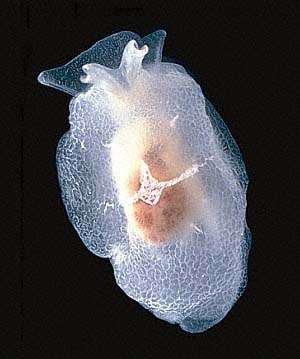
Berthella stellata
(Risso, 1826)
Order: NOTASPIDEA
Superfamily: PLEUROBRANCHOIDEA
Family: Pleurobranchidae
DISTRIBUTION
Worldwide distribution in tropical and temperate waters
PHOTO
Noumea, New Caledonia, October 1988, 15-20mm long. LOWER LEFT showing enrolled rhinophoral head tentacles. PHOTOS: Bill Rudman.
Originally described from the Mediterranean, it is found throughout the Indo-West Pacific and also the tropical west American coast and the Caribbean, under various names. In the Pacific it was usually known as Berthella pellucida. It grows to about 20mm and usually has a translucent white background with a network of white lines around low pustules. The brownish viscera is visible through the mantle wall and most specimens have traces of a white cross-like mark in the centre of the mantle with four white diagonal marks arranged symmetrically, one between each pair of the arms of the cross. The markings are usually more obvious in juvenile specimens. In adults, often only the four diagonal white marks are present. There is a flattened, thinly calcified, but well developed shell embedded in the mantle tissue.
Reference:
• Risso, A. (1826). Les Nudibranches, pp 30-54 In: Histoire des principales productions de l'Europe Meridionale et particulierement de celles des environs de Nice et des Alpes Maritimes, 4.
• Gosliner, T.M. & Bertsch, H. (1988). A review of the genus Berthella (Opisthobranchia: Notaspidea) from the Pacific Coast of North America. The Veliger, 31: 46-67.
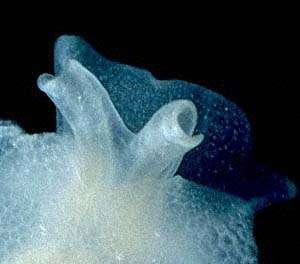

Rudman, W.B., 1999 (March 9) Berthella stellata (Risso, 1826). [In] Sea Slug Forum. Australian Museum, Sydney. Available from http://www.seaslugforum.net/find/bertstel
Related messages
First record of feeding by Berthella stellata
January 14, 2010
From: Jeff Goddard

Hi Bill,
A group of us recently traveled to Baja California with Hans Bertsch for a series of low tides. On New Year's Eve at El Tomatal on the Pacific coast we found numerous Berthella strongi and their egg masses on or adjacent to the plakinid sponge, Oscarella, a known prey item for this species (Goddard, 2007)[message #20217]. We also found two specimens of B. stellata, which I had never seen before.
I collected the Berthella stellata and some Oscarella that was growing on a shell, held them separately for one day, and then placed the slugs and the sponge together. Both specimens consumed the sponge overnight. The large pits in the sponge pictured here represent a night's feeding activity by the slug pictured, which had a dorsum 8 mm long. Brenna Green's close-up image is of the same individual.
Locality: El Tomatal, Intertidal, Baja California, Mexico, Pacific Ocean, 31 December 2009, Cobble field. Length: 8 mm. Photographer: Jeff Goddard (top image), Brenna Green (lower image).
Only one species of Oscarella has been described from the Pacific coast of North America (O. carmela from the Monterey Peninsula), and it's not known yet if there are additional species on this coast. Oscarella is thin, delicate, and slimy to the touch, owing to its lack of skeletal elements.
To our knowledge, this is the first record of feeding by Berthella stellata, and brings to seven the number of species of Berthella now known to feed on plakinid sponges.
- Goddard, J.H.R. (2007). Berthella (Opisthobranchia: Pleurobranchidae) from the Northeast Pacific Ocean prey on plakinid sponges (Homoscleromorpha: Plakinidae). The Veliger 49(2): 97-100
Best wishes,
Jeff
goddard@lifesci.ucsb.edu
Goddard, J.H.R., 2010 (Jan 14) First record of feeding by Berthella stellata. [Message in] Sea Slug Forum. Australian Museum, Sydney. Available from http://www.seaslugforum.net/find/23101
Dear Jeff,
Thanks for this observation. It's great to reach the stage where we can say that a particular genus of slug feeds not just on 'sponges', but specialises on one genus - in this case Plakina. Looking through earlier records on the Forum for B. stellata, I wouldn't be surprised if the sponge in the background of two records [#22041 - from Indian Ocean; #10544 - from Mediterranean] are species of Plakina as well, which would be a nice bit of global confirmation.
Best wishes,
Bill Rudman
Berthella stellata from Ratnagiri, India
December 3, 2009
From: Vishal Bhave
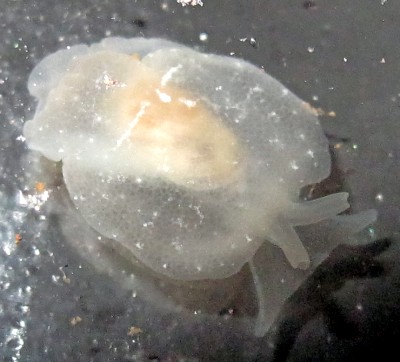
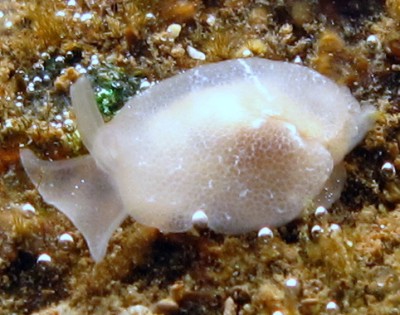
Concerning message #22063:
Seen in a rockpool with large boulder encrusted with Balanus.
Locality: Mandavi, Ratnagiri, 25 cm, Maharashtra, India, Arabian sea, 28 November 2009, Intertidal with rockpools. Length: 18 mm. Photographer: Vishal Bhave.
Vishal Bhave
vishalbhave@gmail.com
Bhave, V.J., 2009 (Dec 3) Berthella stellata from Ratnagiri, India. [Message in] Sea Slug Forum. Australian Museum, Sydney. Available from http://www.seaslugforum.net/find/22920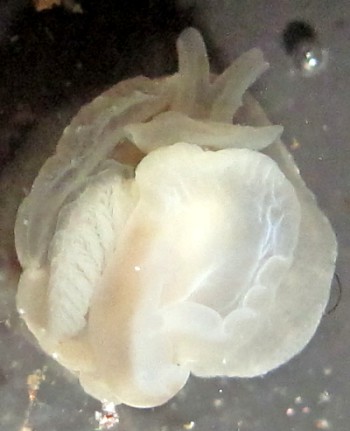
Dear Vishal,
It's good to get a photographic record from India to help fill in some of the gaps in its known distribution. In the upper photo I am pretty sure I can make out the outline of the internal shell which covers the viscera. Thanks also for the nice photo from underneath. It shows the single gill on the right side of the body, which gives these animals their common name of side-gilled slugs.
Best wishes,
Bill Rudman
Berthella stellata found sthrn Queensland
November 21, 2008
From: Gary Cobb
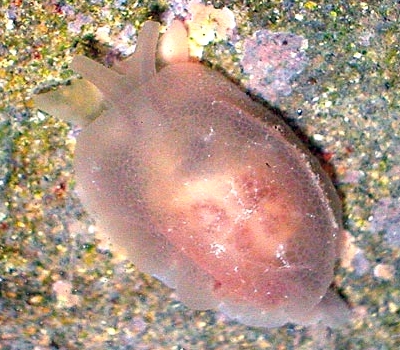
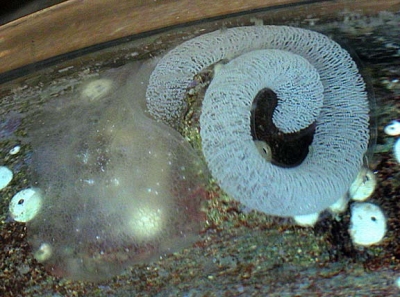
Concerning message #10544:
Hi Bill and everyone!
May I present a record for Berthella stellata, which is quite common here in the sthn Queensland intertidal areas. In regards to it's spawning ... I have never witnessed any 'Slug' that produces an egg mass so large in proportion to its body! The mass is round in diameter and even though it's body is near transparent you can't see eggs within the body.
Locality: Alexandra Headland, Mooloolaba, 100mm, Queensland, Australia, Pacific Ocean, 19 November 2008, Intertidal. Length: 15-20mm. Photographer: Gary Cobb.
I have included a photo of the shell.
Cheers,
Gary
gary@nudibranch.com.au
Cobb, G.C., 2008 (Nov 21) Berthella stellata found sthrn Queensland. [Message in] Sea Slug Forum. Australian Museum, Sydney. Available from http://www.seaslugforum.net/find/22063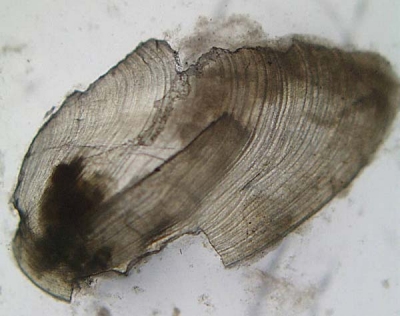
Thanks Gary,
The egg mass is certainly very large in proportion to the animal. Some of the mucus molecules, which make up the jelly surrounding the egg string, have amzing powers of expansion when they come into contact with water. One of the great problems in dissecting the reproductive systems of opisthobranchs preserved in alcohol is to accidently cut into the mucus glands. I usually immerse specimens in water when I dissect and as soon as the mucus makes contact with the water it begins to expand quickly obscuring the rest of the anatomy and making further dissection impossible until all the mucus gland has been cut away.
It's good to get a photo of the fragile internal shell. Like so many 'primitive' sea slugs, the shell is - in evolutionary terms - in the process of disappearing. One character separating the genera Berthella and Berthellina is that in Berthella, the shell is relatively large covering much of the viscera, while in Berthellina it is reduced to a small plate, perhaps a tenth of the width of the mantle. I am pretty sure I can see the outline of the shell in your upper photo.
Best wishes,
Bill Rudman
First Berthella stellata from Reunion Island
November 19, 2008
From: Hugues Flodrops
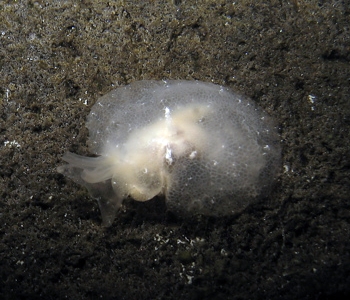
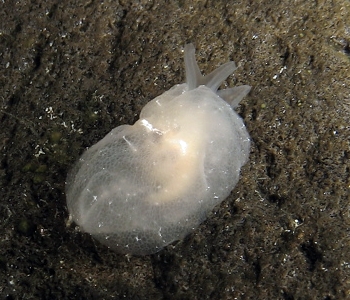
Concerning message #7477:
Hi Bill,
To my mind, this is the first observation in Reunion, of what I think is Berthella stellata. It is possible with its worldwide distribution?
Locality: Etang-Salé "Rocky coast", 1 metre, Reunion Island, Indian Ocean, 5 december 2007. Length: 20 mm. Photographer: Hugues Flodrops.
Best regards.
Hugues
hugues.flodrops@wanadoo.fr
Flodrops,H., 2008 (Nov 19) First Berthella stellata from Reunion Island. [Message in] Sea Slug Forum. Australian Museum, Sydney. Available from http://www.seaslugforum.net/find/22041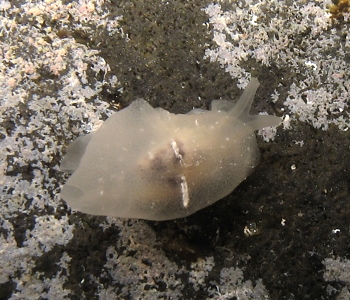
Dear Hugues,
Yes this is Berthella stellata. It has certainly been reported from the Western Indian Ocean before - from Sth Africa as B. tupala and the Red Sea as B. stellata albocrossata. In the eastern Atlantic it has been reported as B. tupala, and in much of the western Pacific as B. pellucida. In southeastern Australia, Burn named it B. postrema. We don't have a good representation on the Forum from the Indo-West Pacific so your record is very welcome.
Best wishes,
Bill Rudman
Berthella sp. from Brazil
February 2, 2006
From: Vinicius Padula

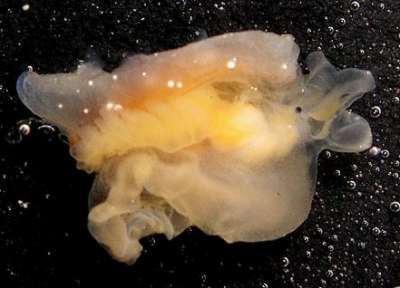
Dear Bill,
I don´t know what species this specimen of Berthella belongs to. Maybe Berthella stellata.
Locality: Rio de Janeiro, Brasil. Atlantic Ocean. Depth: 1 meter. Length: 8 mm. 30 January 2006. Intertidal. Photographer: Vinicius Padula
In the same locality the specimens of Berthella agassizi are pink, with different appearance to this animal (I´m travelling and haven´t photos to send now).
Best wishes,
Vinicius Padula
viniciuspadula@yahoo.com
Padula, V., 2006 (Feb 2) Berthella sp. from Brazil. [Message in] Sea Slug Forum. Australian Museum, Sydney. Available from http://www.seaslugforum.net/find/15726Dear Padula,
One you stop travelling, some photos of pink B. agassizi would be very welcome. It's possible these are B. stellata. Marcus (1957) described Berthella tupala from Brazil, which I am pretty sure is now considered a synonym of the widespread B. stellata.
Best wishes,
Bill Rudman
Other Berthella stellata from Cerbere
August 12, 2003
From: Marina Poddubetskaia
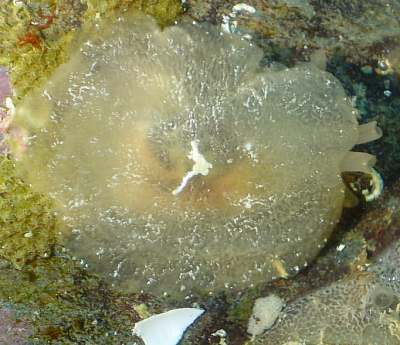

Dear Bill,
As last year, I found several Berthella stellata in Cerbere. All of them were in the same site and under rocks.
The upper photo puzzles me. In the lower right corner you can see a sponge(?) which looks like this Berthella. The similarities are so visible that I wonder if there could be any relationship between them. The second photo shows a different colour form of this species.
Location: Cerbere, France, Mediterranean coast
Site: Les Chambres
Depth: 10-11m
Upper Photo: 12-14mm long, 11 July, 2003
Lower Photo: 15-20mm long, 12 July, 2003
Photos: Marina Poddubetskaia - Nembro website
Best wishes,
Marina.
nembro@nembro.info
Poddubetskaia, M., 2003 (Aug 12) Other Berthella stellata from Cerbere. [Message in] Sea Slug Forum. Australian Museum, Sydney. Available from http://www.seaslugforum.net/find/10544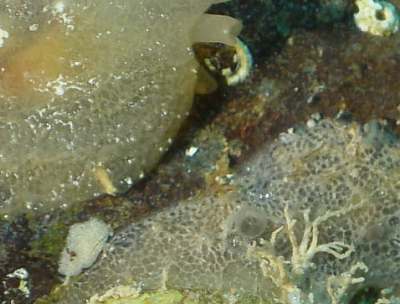
Dear Marina,
Thanks for the photos. This species has a reticulate [network] pattern on its back which is sometimes more noticeable than other times. I guess the degree of white pigmentation affects how visible it is against the transparency of the rest of the skin. The pattern certainly makes it look like the sponge [see close-up of your photo alongside]. Despite it being relatively common we have no good evidence on what this species eats. As I said in an earlier message other species of Berthella have been reported to eat sponges, so it could be a sponge feeder
Best wishes,
Bill Rudman
Re: Berthella stellata? from Turkey
January 15, 2003
From: Juan Lucas Cervera
Dear Bill,
I agree with your ID.
Lucas.
lucas.cervera@uca.es
Thanks Lucas,
Bill Rudman
Berthella stellata? from Turkey
January 13, 2003
From: Baki Yokes
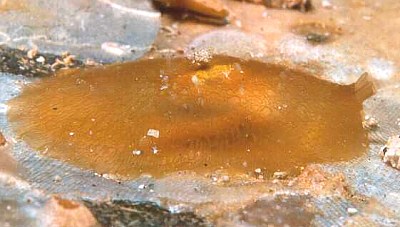
Dear Bill,
Here is a species from Turkey which I couldn't identify. It looks like a Notaspidean. The oscule-like yellow patch on the back reminds me of Berthella plumula.
Location: Antalya, Turkey
Dive-site: Uc Adalar
Size: around 5cm
Photos taken by Adnan Buyuk [ado2000tr@yahoo.com])
What is your suggestion?
Best wishes
Baki
bakiyokes@turk.net
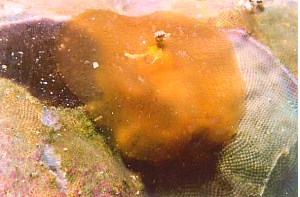
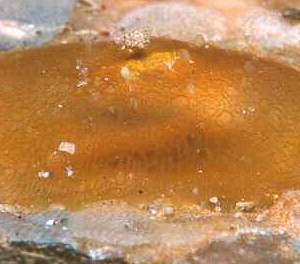
Dear Baki,
I agree that it probably a species of Berthella but I suspect it is the yellow form of Berthella stellata. It appears to have part of the white cross-like markng found in that species in the centre of the mantle rather than a sunken pit which is characteristic of B. plumula. I would welcome comments from anyone familiar with these species. It is interesting to see it on the bryozoan colony. In the lower left photo, the colony seems to have been eaten out except for the brown-purple patch in the upper left of the photo. I wonder if that indicates that it has been eating the bryozoan? We don't know very much about the feeding behaviour of these animals, although some species, such as B. plumula, feed on sponges.
Best wishes,
Bill Rudman
Berthella stellata from French Mediterranean
July 17, 2002
From: Marina Poddubetskaia
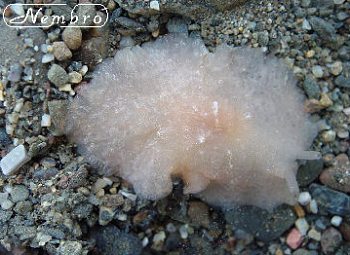
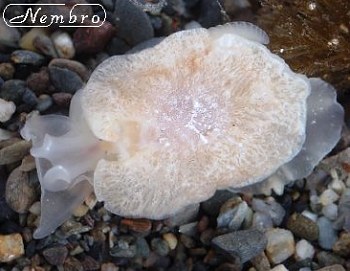
Dear Bill,
Could you help me to identify this Berthella found under a stone during the 'Sea Slugs Training Course' in Cerbere, please. Is it Berthella stellata?
Date: July 05, 2002
Location: Cerbere, France
Site: La Ramere
Size: 35-40mm
Best wishes,
Marina.
nembro@nembro.info
Poddubetskaia, M., 2002 (Jul 17) Berthella stellata from French Mediterranean. [Message in] Sea Slug Forum. Australian Museum, Sydney. Available from http://www.seaslugforum.net/find/7477Dear Marina,
Berthella stellata was first described from the Mediterranean, and is now considered to be a circumglobal species. In the Mediterranean it ranges from this translucent white colour to yellow, but always has some traces of the opaque white star pattern in the centre of the body, on which its name is based.
Best wishes,
Bill Rudman
